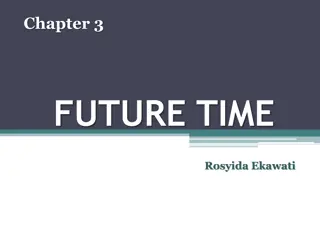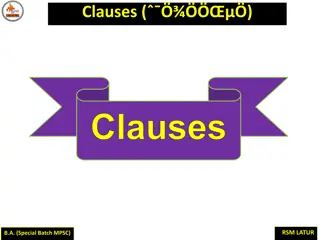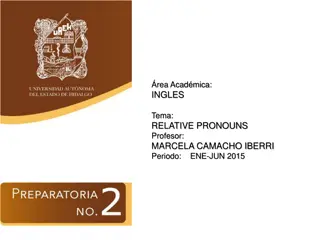Understanding Relative Pronouns and Adjective Clauses in Literature
Explore the use of relative pronouns and adjective clauses in literary works by authors like Gary D. Schmidt and Jim Murphy. Learn the distinctions between "who," "whose," "whom," and "that" in referring to people and things. Practice identifying and creating examples of adjective clauses starting with relative pronouns. Enhance your understanding of grammar elements found in storytelling.
Download Presentation

Please find below an Image/Link to download the presentation.
The content on the website is provided AS IS for your information and personal use only. It may not be sold, licensed, or shared on other websites without obtaining consent from the author. Download presentation by click this link. If you encounter any issues during the download, it is possible that the publisher has removed the file from their server.
E N D
Presentation Transcript
Its the kind of smile you give a chicken. (p 4) - Gary D. Schmidt. Lizzie Bright and the Buckminster Boy She opened the door and stared beyond the picket gate at Willis Hurd and his friends. (p 16) - Gary D. Schmidt. Lizzie Bright and the Buckminster Boy Dead animals were routinely tossed into this soup. (p 2) - Jim Murphy, An American Plague No one knew. (p 9) -Jim Murphy, An American Plague
Its the kind of smile you give a chicken whose head your about to cut off. (p 4) - Gary D. Schmidt. Lizzie Bright and the Buckminster Boy She opened the door and stared beyond the picket gate at Willis Hurd and his friends, who all broke into a sudden and uproarious lighter all except Willis, who was smiling his chicken-killing smile. (p 16) -Gary D. Schmidt. Lizzie Bright and the Buckminster Boy Dead animals were routinely tossed into this soup, where everything decayed and sent up noxious bubbles to foul the air. (p 2) - Jim Murphy, An American Plague No one knew that a killer was already moving through the streets with them, (p 9) -Jim Murphy, An American Plague
Relative Pronouns who, whoever, whose, whom, whomever what, whatever which, whichever that
Adjective clauses are usually introduced by relative pronouns He did that thing again, where he pulled back his lips and showed his teeth It s hard not to immediately fall in love with a dog who has such a good sense of humor. (p. 12) -Kate DiCamillo, Because of Winn-Dixie
Things to consider Which refers to things and animals Who, whose, and whom refer to people That usually refers to things
You try! Using your own library book or the books at your table, find an example of an adjective clause (beginning with a relative pronoun). Write it down, underline the adjective clause and circle the lead relative pronoun, give page number, and put quotes around it. Then, you try and create a sentence similar to the one you found.
Lets Practice hint: see Things to consider in notes The lady that drives our bus is crazy.
Adjective Clause vs. Appositives Influenza is a disease which looms on often- touched surfaces, waiting to infect its victim. Tell which one Influenza, a silent stalker, looms on often- touched surfaces, waiting to infect its next victim. Renames noun
Lets Practice From adjective clause to appositive phrase It s the kind of smile you give a chicken whose head your about to cut off. (p 4) - Gary D. Schmidt. Lizzie Bright and the Buckminster Boy























